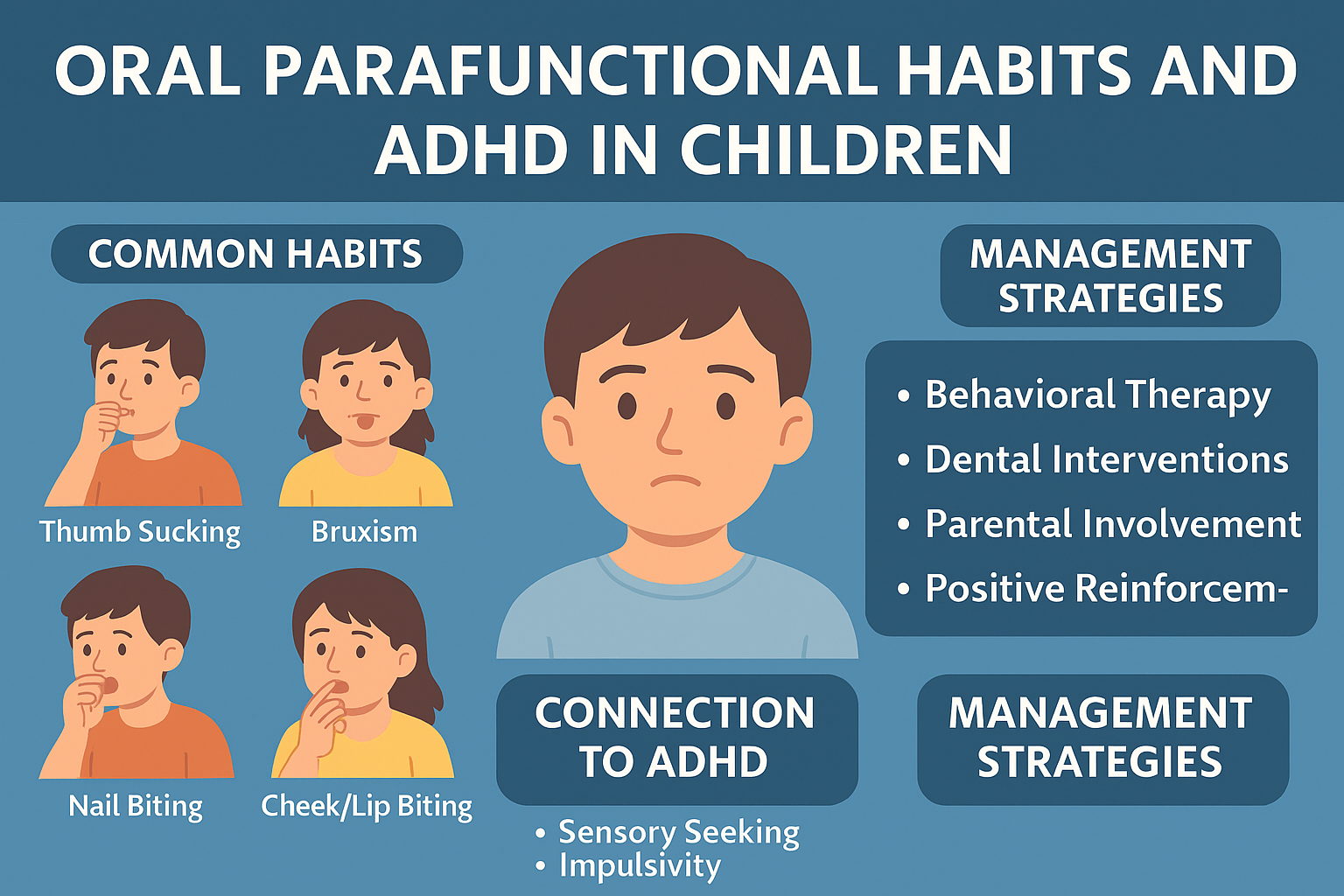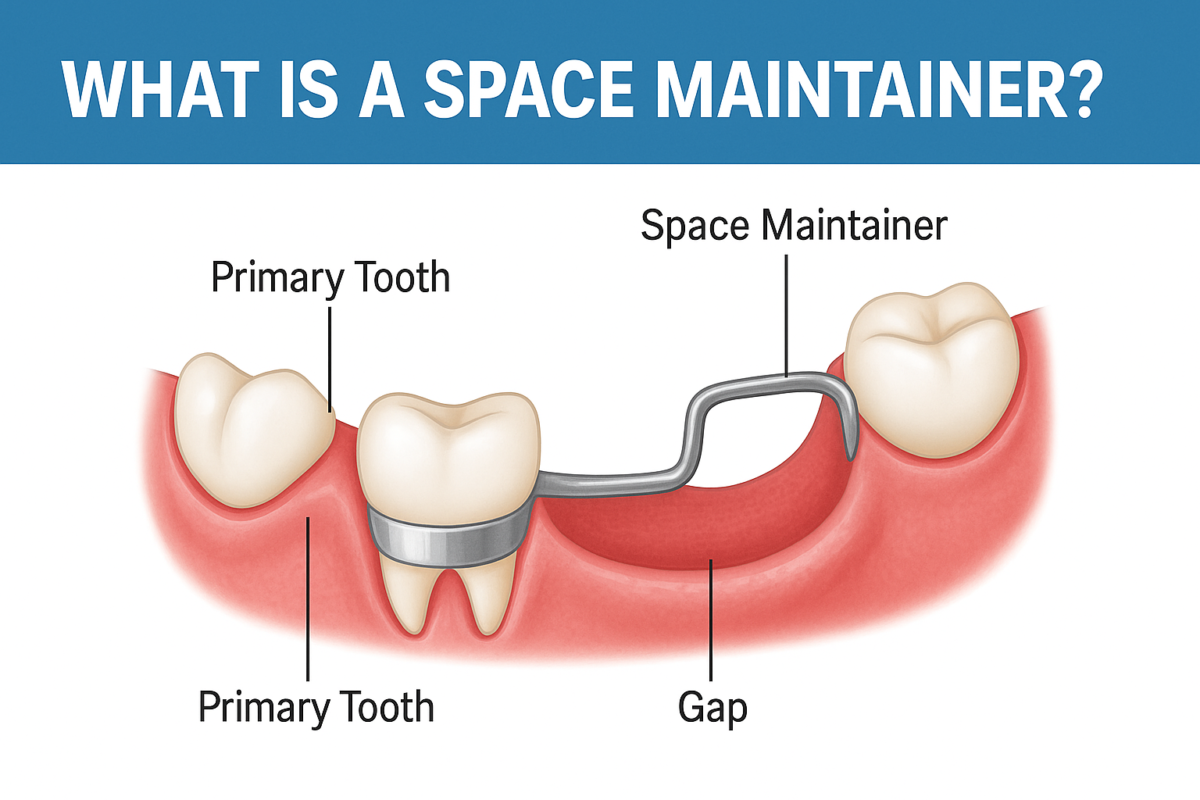
Oral Parafunctional Habits and ADHD in Children
Attention-Deficit/Hyperactivity Disorder (ADHD) affects millions of children worldwide and often manifests in ways beyond classroom attention or impulsive behavior. One lesser-known aspect is its connection to oral parafunctional habits—involuntary, non-functional movements or behaviors involving the mouth, such as thumb sucking, tongue thrusting, bruxism (teeth grinding), and nail biting. These habits can significantly impact oral development, dental health, and even speech patterns in children.
This article explores the intricate relationship between ADHD and oral parafunctional habits in children, how to identify them, their consequences, and what caregivers and dental professionals can do.
What Are Oral Parafunctional Habits?
Parafunctional habits are repetitive oral behaviors that serve no functional purpose, such as:
- Thumb or finger sucking
- Nail biting
- Cheek and lip biting
- Bruxism (teeth grinding)
- Tongue thrusting
- Pencil or object chewing
- Mouth breathing
These behaviors are common in young children but persisting beyond early childhood may lead to developmental problems.
ADHD in Children: A Quick Overview
ADHD is a neurodevelopmental disorder marked by inattention, hyperactivity, and impulsiveness. In children, it often shows up as:
- Difficulty focusing or following instructions
- Excessive talking or moving
- Impulsive actions
- Trouble regulating behavior and emotions
Children with ADHD also tend to have higher levels of stress and sensory-seeking behaviors, which can lead to the development or persistence of oral parafunctional habits.
How Are Oral Parafunctional Habits Linked to ADHD?
- Sensory Seeking and Self-Soothing Behavior
Children with ADHD often engage in repetitive behaviors as a form of sensory self-regulation. Chewing on objects or grinding teeth may offer calming effects.
- Increased Anxiety and Stress
ADHD is frequently associated with anxiety, which is a known trigger for habits like bruxism or nail biting.
- Poor Impulse Control
Difficulty in regulating actions and habits often means children with ADHD struggle to stop harmful oral behaviors, even after repeated instructions.
- Sleep Disturbances
Many children with ADHD have poor sleep hygiene, increasing the likelihood of nighttime bruxism (tooth grinding).
- Oral-Motor Dysfunction
Some studies suggest a correlation between ADHD and delayed oral-motor development, which can lead to behaviors like tongue thrusting and mouth breathing.
Common Oral Parafunctional Habits in Children with ADHD
| Habit | Description | Common Complications |
| Thumb Sucking | Repetitive sucking on the thumb | Protrusion of front teeth, open bite, speech issues |
| Bruxism | Grinding/clenching of teeth | Tooth wear, jaw pain, headaches |
| Tongue Thrusting | Pushing tongue forward against teeth | Improper bite, speech delay |
| Nail Biting | Biting fingernails | Tooth chipping, infection risk |
| Cheek/Lip Biting | Biting inner cheeks or lips | Oral ulcers, soft tissue trauma |
| Object Chewing | Chewing pencils, clothing, etc. | Damage to teeth, choking hazard |
Oral Health Risks of These Habits
- Malocclusion: Improper alignment of teeth and jaws
- Tooth damage: Enamel wear, chipping, fractures
- Speech problems: Lisp, difficulty pronouncing certain letters
- TMJ Disorders: Temporomandibular joint issues from clenching
- Infections: Open wounds in the mouth from biting may get infected
- Delayed dental development: Especially with prolonged thumb sucking or tongue thrusting
Early Detection: Signs for Parents and Dentists
Early identification is key. Look for:
- Persistent or severe habits beyond age 4–5
- Excessive wear on teeth
- Jaw discomfort or clicking sounds
- Open bite or misalignment
- Nighttime teeth grinding
- Irritability in the morning (sign of poor sleep quality)
Management Strategies
👨⚕️ Multidisciplinary Approach
Involves collaboration between:
- Pediatric dentist
- Pediatrician
- Child psychologist/behavioral therapist
- Speech therapist (if needed)
🧠 Behavioral Therapy
- Habit-reversal training
- Positive reinforcement
- Fidget tools or oral chew devices (safe alternatives)
🪥 Dental Interventions
- Mouthguards for bruxism
- Orthodontic appliances for tongue thrust
- Space maintainers or interceptive braces if misalignment develops
- Regular check-ups for monitoring progress
🏡 Parental Involvement
- Monitor behavior closely
- Avoid punishment—focus on support and positive reinforcement
- Offer sensory-safe chewing tools
- Create a stress-free home routine
Can These Habits Be Prevented?
While completely preventing oral parafunctional habits in ADHD children may not be realistic, you can minimize their severity and impact with:
- Early diagnosis and ADHD management
- Scheduled dental visits every 6 months
- Creating structured daily routines
- Using appropriate coping tools (e.g., chewable jewelry or fidget toys)
- Educating the child about healthy oral behavior
Summary
Children with ADHD are more prone to developing oral parafunctional habits due to sensory, emotional, and behavioral challenges. These habits can lead to various oral complications if not addressed early. A comprehensive, multidisciplinary approach involving behavior modification, dental treatment, and caregiver support is essential.
Final Thoughts
Understanding the link between oral health and behavioral conditions like ADHD helps caregivers and dental professionals manage issues more effectively. If you suspect that your child’s oral habits may be more than just a phase, consult a pediatric dentist and ADHD specialist for timely intervention.
FAQs
- Can ADHD cause children to develop teeth grinding habits?
Yes, children with ADHD often exhibit stress and hyperactivity, which can manifest as bruxism (teeth grinding), especially during sleep. - Is mouth breathing linked to ADHD or just a separate issue?
Mouth breathing is often seen in children with ADHD. It may not be a direct cause but can worsen symptoms due to poor sleep quality and reduced oxygen intake. - What are early signs of parafunctional habits in ADHD children?
Early signs include nail biting, lip sucking, clenching, pencil chewing, and repeated tongue thrusting, usually observed during tasks or rest. - Do parafunctional habits worsen ADHD behavior?
Indirectly, yes. Discomfort, pain, or poor sleep caused by oral habits may escalate attention difficulties or emotional responses. - Are these habits more common in boys with ADHD than girls?
Studies suggest boys with ADHD may show higher rates of aggressive parafunctional behaviors like bruxism, but both genders are affected. - Is it necessary to treat all oral habits in children with ADHD?
Not all require treatment, but if a habit affects oral health (e.g., open bite, gum recession, or TMJ pain), intervention is essential. - Can occupational therapy help control oral parafunctional habits?
Yes, occupational therapists can help by using sensory integration techniques and calming strategies tailored to ADHD children. - How can teachers help manage these habits in school?
Teachers can provide fidget tools, schedule sensory breaks, and avoid punishment, helping the child redirect these habits positively. - Is there a link between diet and oral habits in ADHD children?
Nutritional imbalances (like iron, magnesium, or zinc deficiency) may increase restlessness and oral habits; a healthy diet can help reduce their frequency. - Can untreated oral habits impact speech development in ADHD children?
Yes. Tongue thrusting or prolonged thumb sucking may cause articulation issues, lisps, or delayed speech, especially when combined with ADHD-related impulsivity.

